
Agricultural Bio-Waste-Derived KOH-Activated Carbon for Chromium(VI) Remediation: Reaction Pathways and Kinetic Behavior in Aqueous Media
Mudar Al-Okla, Habib Aziz Hassan, Hani Zeidan
35 просмотров
Аннотация:
This study examines the influence …
This study examines the influence of the activation ratio on the properties of potassium hydroxide-activated carbon (KOH-AC) derived from safflower stems and its performance in hexavalent chromium Cr(VI) adsorption. The adsorbent was characterized using Brunauer–Emmett–Teller (BET) surface area analysis, Scanning Electron Microscopy (SEM), energy-dispersive X-ray spectroscopy (EDX), Fourier Transform Infrared spectroscopy (FTIR), and X-ray diffraction (XRD) to evaluate porosity, morphology, and crystallinity. Key adsorption parameters—including pH, contact time, initial concentration, temperature, and adsorbent dosage—were systematically investigated. The optimal activation ratio (KOH-activated carbon with 4:1 KOH to carbon; KAC-4) yielded a highly porous carbon with a BET surface area of 2089.5 m²/g and a maximum Cr(VI) adsorption capacity of 132.3 mg/g. The highest removal efficiency was achieved at pH 5.2. Kinetic analysis revealed that adsorption followed a pseudo-second-order model, indicating chemisorption, while thermodynamic results suggested an exothermic and non-spontaneous process with decreased adsorption at higher temperatures—implying a dominant physisorption mechanism governed by electrostatic interactions. The Freundlich isotherm provided the best fit, confirming multilayer adsorption on a heterogeneous surface.
Overall, KOH-activated carbon from safflower stems proved to be a promising, low-cost, and sustainable adsorbent for Cr(VI) removal, supporting agricultural waste valorization and circular economy initiatives.
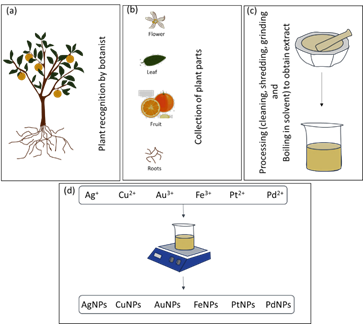
Environmentally Friendly Synthesis of Inorganic Nanoparticles Using Plant Extracts
Naved Azum, Tahseen Kamal, Malik Abdul Rub, Mohammad Asad, Anish Khan, Aftab Aslam Parwaz Khaa, Muhammad Tariq Saeed Chani, Muhammad Nadeem Arshad, Khalid Ahmed Alzahrania, Hadi M. Marwani
1 просмотров
Аннотация:
This review examines inorganic metal …
This review examines inorganic metal nanoparticles due to their unique properties, stability, and significant applications in catalysis, environmental remediation, sensing, and biomedical applications. The nanoparticles discussed include silver (Ag), gold (Au), copper oxide (CuO), iron oxide (Fe2O3), platinum (Pt), and palladium (Pd). These materials offer advantages such as high surface-to-volume ratios, tunable properties, catalytic efficiency, and pronounced antimicrobial activity. Their robust bonds and crystalline structures contribute to their stability. The review emphasises recent advancements, particularly from the past two years (2024 & 2025), to provide an up-to-date overview of key developments. Plant-mediated nanoparticles demonstrate notable antimicrobial, antioxidant, and catalytic properties, supporting their potential for biomedical and industrial applications. However, challenges remain, including low synthesis yields, scalability issues, and the complexity of plant extract compositions. Future research should focus on optimising synthesis protocols and elucidating underlying mechanisms to improve nanoparticle performance and facilitate large-scale implementation.
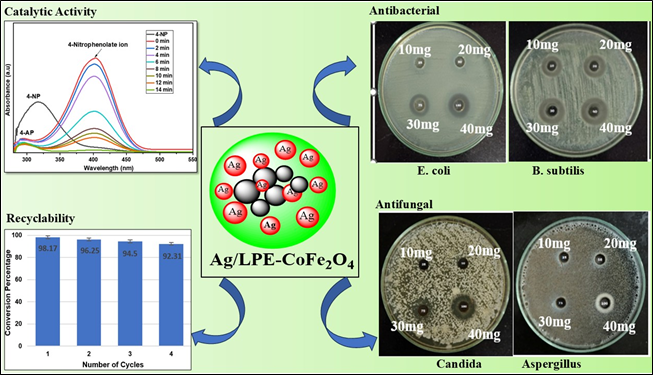
Silver Decorated Lemon Peel Extract Functionalised Cobalt Ferrite Nanocomposite: Characterization, Multifunctional Antimicrobial and Catalytic Applications
Swati Gubbala, Gayathri Bindu Kurup, Prashanth Goud Banda, Raghasudha Mucherla
0 просмотров
Аннотация:
A biogenic strategy was employed …
A biogenic strategy was employed to develop a multifunctional magnetic nanocomposite by first synthesizing cobalt ferrite (CoFe₂O₄) NPs and subsequently functionalizing it with lemon peel extract (LPE) rich in phenolics and flavonoids. The LPE acted like a biogenic reducing and stabilizing agent, facilitating the in-situ decoration of silver nanoparticles (Ag NPs) and yielding a novel ternary nanocomposite (Ag/LPE–CoFe₂O₄). Successful functionalization and Ag incorporation was confirmed by FTIR, XRD, FESEM, XPS, HRTEM, EDX and VSM. The Ag/LPE–CoFe₂O₄ nanocomposite exhibited noticeably enhanced antimicrobial activity against Gram-positive (S.aureus, B.subtilis), Gram-negative(K.pneumoniae, E.coli), and fungal strains (Candida, Aspergillus), resulting from the synergistic action of CoFe₂O₄, LPE phytochemicals, and Ag NPs. Catalytic tests further exhibited rapid reduction of 4-Nitrophenol(4-NP) to 4-Aminophenol(4-AP) under ambient conditions with a rate constant of 0.28±0.02 min-1 and complete conversion is achieved in 14 min. This study highlights the novelty of promoting citrus peel waste to engineer an Ag-decorated, magnetically retrievable nanocomposite that integrates recyclability, catalytic efficiency, and broad-spectrum antimicrobial activity. These results demonstrate Ag/LPE–CoFe₂O₄ NPs as an ecofriendly multifunctional nanocomposite with strong potential in environmental remediation and biomedical fields.
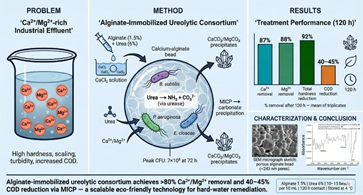
Development Of Immobilized Microbial Beads For Bioremediation Of Calcium- And Magnesium-Rich Effluents
D. R. Poojitha, G. Vijaya Kumar, B. Trilok Chandran, A. N. Prakash, R Prakash
0 просмотров
Аннотация:
Industrial effluents enriched with calcium …
Industrial effluents enriched with calcium (Ca2+) and magnesium (Mg2+) ions increases water hardness, causing scaling, and contributing to environmental degradation. The present study investigates a development of calcium alginate beads immobilized with ureolytic bacteria B. subtilis, P. aeruginosa, and E. cloacae supplemented with urea. The immobilization matrix having stabilized microbial activity with enhanced ion removal efficiency through microbially induced carbonate precipitation (MICP). The composite beads were evaluated for their impact on removal of Ca2+, Mg2+ ions, reduction in COD, Turbidity, and total hardness from the effluents stream. The results demonstrated over 80% reduction in Ca2+ and Mg2+ ions, with improved clarity and reduced organic load in treating effluents. SEM and FTIR images of immobilized beads with bacteria confirmed the structural and functional integrity of the beads after encapsulation. The microbial consortium retained high viability and tolerance throughout the treatment process, affirming the robustness of the immobilized system. This eco-friendly methodology holds promise for scalable applications in the remediation of hard water and ion-rich industrial discharges.
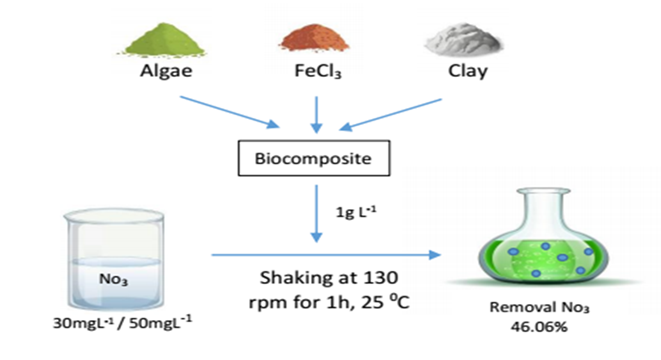
Clay-microalgae Biocomposite for Enhanced Nitrate Removal from Water
M. Tabatabaei Khodadadei, H. Mansouri, H. Salari
72 просмотров
Аннотация:
Live and dead microalgae have …
Live and dead microalgae have the potential to remove mineral nutrients such as nitrogen from water resources. In this research, the efficiency of biocomposites prepared from different ratios of dried biomass of Chlorella sorokiniana microalgae together with kaolin and iron chloride for nitrate removal from water was investigated. The effect of pH on the nitrate adsorption capacity of microalgal biomass for different initial nitrate concentrations (30 and 50 mg L-1) was studied. The optimum pH value was found to be about 5. The adsorption efficiency decreased at higher pH. The best performance was achieved by the 50% algae + 50% clay biocomposite, with an adsorption capacity of 14.25 mg g-1 (47.5%) of nitrate at a concentration of 30 mg L-1. The biocomposite of 50% algae + 35% clay + 15% FeCl3 also showed similar performance in nitrate adsorption at a concentration of 30 mg L-1 (46.06%). With increasing nitrate concentration, the removal by microalgal biomass and biocomposites did not increase. Adding FeCl3 to the biocomposite did not increase nitrate adsorption compared to the 50% algae + 50% clay biocomposite. The lowest removal rate of 2.46 mg g-1 related to dry biomass was obtained at a concentration of 50 mg L-1. The morphological structure of the adsorbent was investigated by SEM microscopy and the functional groups by FTIR method. Based on the obtained results, it can be concluded that the prepared composite has a high ability to remove nitrate from water sources.
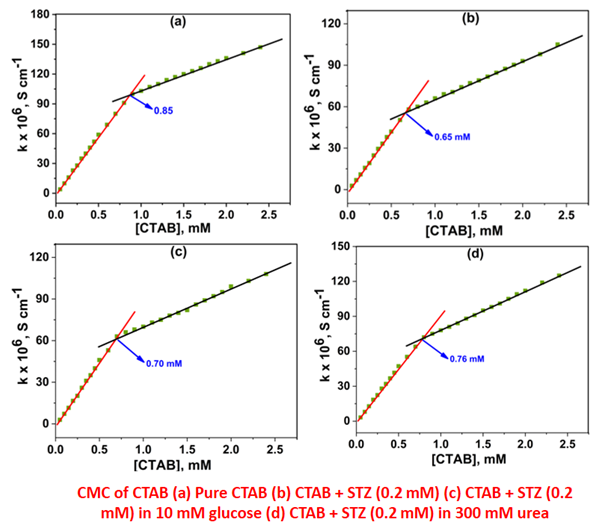
Impact of Glucose and Urea on Micellization of the Cetyltrimethylammonium Bromide - Sulfathiazole System Under Different Temperature Conditions
Abhishek Srivastava, Ikechukwu Ugbaga Nkole, Krishna Srivastava, Neetu Srivastava
4 просмотров
Аннотация:
The present investigation employs a …
The present investigation employs a conductometric approach to investigate the influence of differing concentrations of the antibiotic drug sulfathiazole (STZ) and the additives glucose/urea on the micellization behavior of the cationic surfactant cetyltrimethylammonium bromide (CTAB) in a slightly acidic environment (рН 5.0) across a range of temperatures. The aim of this study is to elucidate the influence of surfactant-drug interactions on micelle formation and dynamics, thereby establishing the possibility of advancing drug delivery systems and enhancing the therapeutic efficacy of drugs. Unlike CTAB in pure water, the CMC (critical micellar concentration) values of CTAB decreased in the presence of STZ, i.e. micellization was facilitated. Both glucose and urea increase the CMC of the CTAB + STZ system. Unlike urea, which destabilizes water structure and diminishes hydrophobic contacts, glucose stabilizes the water structure, making it harder for CTAB molecules' hydrophobic tails to form micelles. The relationship between the CMC of the CTAB + STZ and temperature displayed a linear trend for both aqueous media and aqueous glucose/urea environment. Thermodynamic parameters (change in entropy of micellization, ΔS0m; enthalpy of micellization, ΔH0m; and Gibbs free energy of micellization, ΔG0m) and physicochemical variables (CMC and counter ion dissociation, α) have been used to characterise the interaction between CTAB and STZ. The negative ΔG0m values reveal that the CTAB + STZ mixture undergoes spontaneous micellization in both pure water and aqueous glucose/urea environments. The values of −ΔH0m and +ΔS0m for the CTAB + STZ mixture indicate that both electrostatic and hydrophobic interactions play a crucial role in aggregation.
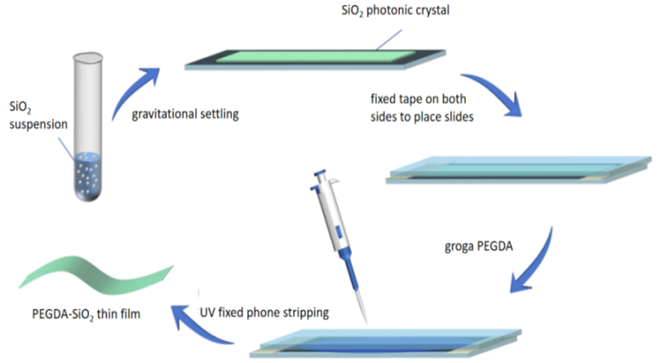
Preparation and properties of PEGDA-SiO2 flexible films
Yijiao Sun, Zhiyue Zhang Weihong Gao, Jie Zhu, Bingjie Xin
0 просмотров
Аннотация:
This study developed a simple …
This study developed a simple and efficient method for preparing PEGDA-SiO₂ flexible films. Silicon dioxide photonic crystals were prepared using the gravity precipitation method, and PEGDA was introduced into them using capillary penetration technology. After UV curing, self-supporting flexible films were rapidly obtained. This method enables precise control of structural color by adjusting the size of silica microspheres, allowing the film to exhibit reversible visibility characteristics under different backgrounds (especially when switching between black and white backgrounds), offering unique advantages in anti-counterfeiting applications. The resulting films exhibit not only good mechanical strength and flexibility but also demonstrate significant potential in smart sensing and energy-saving coatings due to the photonic crystal structure's responsiveness to external stimuli.